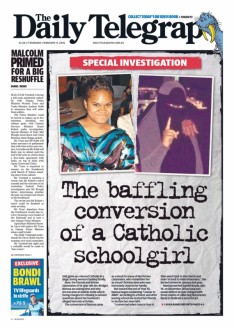ABCs: The Age sees digital subscriptions slide as The Australian nearly doubles AFR print sales
 Digital subscriptions for Fairfax Media’s two main metro newspapers again dropped quarter-on-quarter, according to the latest audit measurements, with The Age’s digital subscriptions also dropping year-on-year for the first time.
Digital subscriptions for Fairfax Media’s two main metro newspapers again dropped quarter-on-quarter, according to the latest audit measurements, with The Age’s digital subscriptions also dropping year-on-year for the first time.
In the August to December quarter, The Age slipped backwards by 2,280 subscribers compared with the same time last year, while quarter-on-quarter the masthead lost 2,513 subscribers.
The Sydney Morning Herald grew its digital subscriptions year-on-year by 2.1% to 138,165, although they slipped back compared with the previous quarter by 1,587 subscribers.
Steve Allen, principal of Fusion Strategy, put The Age’s year-on-year digital declines down to the “quirks” of the Melbourne marketplace.
“Melbourne has always been a different market for newspapers. It’s always been a market where the two mastheads are not as far apart demographically and not as far apart in the quality of journalism,” Allen told Mumbrella.
“The Herald Sun is not a scantily-clad populist daily, it’s always been more serious and had huge coverage of sport. The Age has always been under more pressure than the Sydney Morning Herald has been.
“The fact that the Melbourne market hasn’t quite embraced digital in the same way as the Sydney market has is just one of those quirks of the Melbourne population versus the Sydney population.”
Overall, Allen described the audit as “not bad”.
“They’ve slowed up circulation declines a little bit and course they win back most of that when you include digital for those titles that are in that race,” he said.
“The newspapers are dealing with the challenge of the internet and they’re doing quite well within the marketplace on worldwide comparisons.”
Both The Age and The Sydney Morning Herald posted declines across their total paid masthead sales (print and digital) with The Age down year-on-year 4.6% to 193,383, and SMH down 2.5% to 208,472.
A Fairfax Media spokesperson once again flagged the newspaper industry-backed readership metric EMMA as a more relevant barometer of performance.
“Paid circulation metrics alone aren’t reflective of the large-scale, cross-platform audiences we reach,” she said. “We focus on total masthead readership which reflects our print, web, mobile and tablet audiences.”
The declines come as News Corp’s two papers in the digital circulation audit, The Australian and The Herald Sun, both made double-digit, year-on-year percentage gains; however, both titles remain well behind Fairfax’s numbers.
The Herald Sun saw its Monday to Friday digital subscribers swell by a 35.30% to sit at 66,866 digital subscribers, an increase of 3,251 digital subscribers on the June quarter.
News Corp Australia CEO Peter Tonagh said, in a statement: “Our digital subscriptions continue to go from strength to strength. The Herald Sun now has almost 67,000 digital subscribers, which is up 35% on the same time a year ago, and The Australian now has over 75,000 digital subscribers, which is up +14% on the same time last year. ”
News Corp still refuses to release digital subscription data for the Daily Telegraph, The Courier Mail and Adelaide Advertiser.
National newspaper, The Australian, saw its Monday to Friday digital subscribers grow by 14.1% year on year to 75,018, up 1,900 subscriptions on the June quarter.
![]() The Australian’s digital growth comes as it edges came within 800 copies of doubling rival Australian Financial Review’s Monday to Friday print circulation.
The Australian’s digital growth comes as it edges came within 800 copies of doubling rival Australian Financial Review’s Monday to Friday print circulation.
The Australian posted a December quarter Monday to Friday print circ of 102,068, down 2.6% on the same period in 2014.
The AFR saw its circulation drop by 10.5%, falling to 51,425 copies from 57,451 in the December quarter 2014.
Fusion Strategy’s Allen said: “It’s taken 50 years for The Australian to slowly build its credentials in the marketplace and slowly extend its lead over the Fin Review.
“It is a national newspaper and has peculiar strengths. It has big circulation biases to south-east Queensland and to Western Australia, and to a lesser extent South Australia.”
The Weekend Australian performed the best out of the nationals, with its print circulation suffering a modest decline of 1.2% to sit at 224,691.
The weekend edition of the AFR saw sales slide by 8% from 63,621 in the 2014 December quarter to 58,523 in the 2015 December quarter.
Fairfax Media’s other titles also saw declines in their print sales – The Sydney Morning Herald led the charge, with a decline of 9.1% year-on-year, with print sales sliding to 104,155 in the December quarter.
The Age slipped by 8.7% from 106,843 in the December quarter 2014 to 97,503 in the December quarter 2015.
Both masthead’s Saturday editions also posted declines year-on-year, with The Sydney Morning Herald dipping by 7.6% to sit on 194,207 average daily copies sold in the December quarter.
The Age posted a similar decline, sliding by 7.5% to 166,917 copies shifted during the December quarter.
Both mastheads also saw their Sunday titles decline, with the Sun-Herald again the hardest hit. The Sun-Herald saw its circulation slide from 227,340 copies sold on average to 200,851 copies, a decline of 11.7%.
The Sunday Age slipped by 7.5%, year-on-year, from 147,017 to 136,043. However, quarter on quarter sales grew, with the paper selling 135,731 copies in the June quarter of last year.
 Fairfax Media’s Canberra Times posted the largest decline across the Monday to Friday titles, with its sales down 18.7% year-on-year to sit at 18,837 for the December quarter.
Fairfax Media’s Canberra Times posted the largest decline across the Monday to Friday titles, with its sales down 18.7% year-on-year to sit at 18,837 for the December quarter.
To News Corp and its Sydney tabloid The Daily Telegraph saw circulation slip by 6.5% to 255,448 from 273,241.
![]() News Corp’s Brisbane title The Courier Mail posted a Monday to Friday circulation decline of 5.60%, slipping below the 150,000 mark. The masthead on average shifted 149,408 copies during the December quarter.
News Corp’s Brisbane title The Courier Mail posted a Monday to Friday circulation decline of 5.60%, slipping below the 150,000 mark. The masthead on average shifted 149,408 copies during the December quarter.
Adelaide’s The Advertiser also posted a Monday to Friday sales drop, posting a December 2015 quarter circulation of 126,856 compared with the 158,286 figure the masthead delivered in the same time in 2014.
Hobart’s The Mercury fared the best out of the News Corp titles, with its circulation sliding by 4.6% to 31,578.
The traditionally-more-resilient Seven West Media’s The West Australian continued the downward trend, posting a Monday to Friday decline of 5.6%, sliding below the 150,000 mark with a circulation of 149, 486.
The Northern Territory News was the only positive amongst the Monday to Friday titles, posting 0.40% growth year-on-year. The title grew from 13,670 copies sold in the December 2014 quarter to 13,728 sold in the December 2015 quarter.
Moving to the Saturday editions, it was once again was not a pretty picture. Fairfax Media’s Canberra Times slid by 10.4% year-on-year from 32,094 to 28,750. It was the hardest-hit masthead, with News Corp’s Saturday edition of the Herald Sun faring the best.
The Herald Sun posted a circulation of 347,175, down 4.2% year-on-year from 362,399.
 The Daily Telegraph dropped from 275,380 Saturday papers sold on average in the 2014 December quarter to 257,943 shifted in the December 2015 quarter.
The Daily Telegraph dropped from 275,380 Saturday papers sold on average in the 2014 December quarter to 257,943 shifted in the December 2015 quarter.
Fellow News Corp title The Courier Mail also saw its Saturday sales slip, declining by 4.2% to sit at a circulation of 189,654, down from 197,963 from the same time in 2014.
The Advertiser also saw its Saturday sales drop away by 5.6% from 178,350 to 168,293.
The Mercury posted a decline of 6.5%, sliding from 45,367 to 42,423.
The Northern Territory News also posted a decline of 7.3%, slipping from 19,636 to 18,198.
Looking to the Sunday editions, Fairfax’s Sun-Herald was the hardest hit with a decline of 11.70%, followed by Seven West Media’s Sunday Times, which saw its sales drop by 10.2% year-on-year from 204,892 to 184,012.
Canberra Times’ Sunday paper saw its sales slip by 8.7% to sit on 19,700 while The Sunday Telegraph, owned by News Corp, experienced a sales dip of 7.5%.
The paper remained the highest selling, with a circulation of 452,377.
Sales of Brisbane’s Sunday Mail slid from 363,068 to 339,748, while Adelaide’s Sunday Mail posted a decline of 6.7%, from 214,609 to 200,264.
The Sunday Tasmanian’s sales fell to 40,232 from 42,645, while The Sunday Territorian was the only positive amongst the Sunday mastheads, growing its sales by 6.3% from 14,450 copies sold at the end of 2014 to 15,363 at the end of last year.
Miranda Ward




 Linkedin
Linkedin
It’s wrong to compare the oz with afr. One is a pure biz paper. The oz is really competing with metros which is why is does well in Brisbane and Adelaide. The afr is simply a bad business paper that is becoming tawdry on occasion. But the very strange thing is its refusal to publish digital subscriptions which should be large, probably bigger than the print number?
User ID not verified.
If looking at the Fairfax stable doesn’t tell you straight away what is wrong with this horrible, stupid company, this will: http://quadrant.org.au/rotting-head/
How does a board and management so absolutely inept get to keep drawing salaries. Fairfax could have hired journalists and done journalism. Instead they launched Daily Life and made Clementine Ford the poster girl for everything that’s wrong about the joint..
Fairfax deserves whatever happens to them. Although, as the Quadrant writer points out, Melbourne (and Sydney) will soon have only one paper apiece, a crappy one.
User ID not verified.
“Fairfax Media’s Canberra Times posted the largest decline across the Monday to Friday titles, with its sales down 18.7% year-on-year to sit at 18,837 for the December quarter.”
I can vouch for that. They lost two more subscribers last Monday when I cancelled the home delivery which had been in place – unbroken – since we moved to Canberra in 1970. I got sick of their constant advocacy parading as journalism on subjects such as refugees, climate change, women’s sport and foreign crap. Repeated complaints to them via letters, emails and Facebook didn’t stop the garbage so I took matters into my own hands.
User ID not verified.
There are two things wrong with this article: the AFR loses a lot less money that the Australian and may even make a small profit. The Australian loses plenty. So. what’s the definition of success? Separately, to say that “newspapers are dealing with the challenge of the internet and doing quite well” borders on laughable for anyone who is currently involved in the financial side of the game. Newspapers have no idea how to monetise the internet – check out how many are changing their strategy between paywalls, freemium etc. If newspapers knew how to deal with the internet, the Daily Telegraph would release its digital subscriber numbers.
User ID not verified.
They were giving away The Australian with the Telegraph weren’t they ?
User ID not verified.